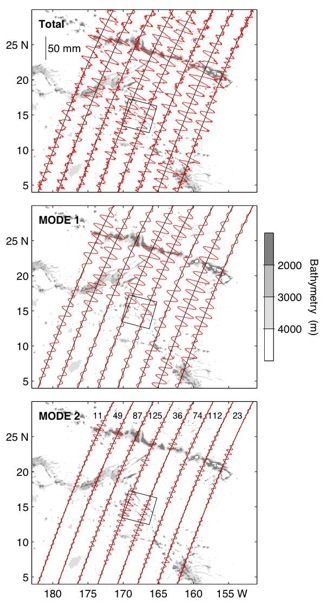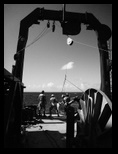INTERNAL TIDAL SCATTERING FROM MIDOCEAN TOPOGRAPHY
The EXperiment on Internal Tidal Scattering (EXITS) aims to understand how low-mode internal tides scatter from midocean topography, such as seamounts and submarine ridges. Low-mode internal waves can propagate far away from their source regions. Via wave-wave interactions, encounters with current shear at eddies or fronts, and scattering at topography, low-mode tidal energy is transferred eventually into small-scale shear instabilities and mixing. Thus energy is removed from the low-mode internal tides far from their source regions, which affects not only the overall tidal energy budget but also the energy available for open ocean mixing.

Strong energy fluxes emanating from Hawaii encounter the steep topography at the Line Islands Ridge and scatter into higher modes. Altimetric measurements show a transformation of incoming mode 1 internal tides into the outgoing mode 2 near the Line Islands Ridge (boxed area). Modelling suggests elevated mixing in the scattered internal tides. During EXITS we are making in situ observations of the scattering of low-mode internal tides at the Line Islands Ridge.
A decrease of southward mode 1 flux across the ridge is seen from LADCP/CTD stations on cruise 1 of at least 24 hours duration.
The increase in mode-2 energy density is found directly in the lee of the ridge. Mode-1 energy density decreased in this area before showing some increases further south.
The largest dissipation estimates occur at one station on the south side of the ridge where scattering from mode 1 to mode 2 appears to be taking place. Size of the dot is proportional to log(dissipation) and the circles denote 3 standard deviations. Calculation and figure by Caitlin Whalen (SIO).
This research was funded by the National Science Foundation.
